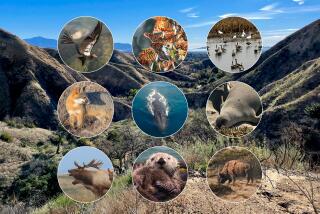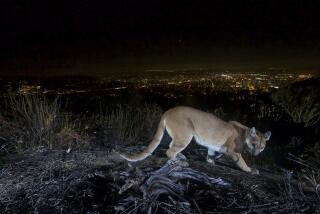Sandhill crane migration brings flocks of tourists, too
Just before sunrise, a hardy band of men and women gathered near a barley field in the remote San Luis Valley to await the dawn.
Some fiddled with their cameras while others nervously scanned the cold, empty sky.
As golden sunlight broke over the mountains, a distant trumpeting filled the air. Thousands of primeval-looking birds with long necks and dagger-like beaks appeared overhead. Their numbers were staggering, the noise deafening.
As they spiraled raucously down onto the field, cameras fired from every direction.
“That’s why I’ve come here for 20 years,” said Kerry Driggers, a retired engineer from suburban Denver, “to witness this ancient spectacle.”
For uncounted generations, the spring arrival of the greater sandhill cranes to the San Luis Valley has been a rite of passage, one memorialized by a 12,000-year-old petroglyph on nearby Dog Mountain.
The cranes travel from New Mexico in flocks of 25,000 or more to eat and cavort before heading north to Idaho, Montana and beyond. The almighty din raised by so many birds sounds a bit like a rollicking New Year’s Eve party at the stroke of midnight — a sustained chorus of honking, squawking and rapid-fire trilling heard for miles.
“I know people who go to Africa on safari but don’t realize one of the top animal migrations on Earth is happening right in their own backyard,” said Scott Cowan, 41, watching the clamorous cranes bounce about the field. “I’m just amazed. It’s quintessential nature.”
Cowan was one of thousands of birders and photographers who came to Monte Vista this month for the 30th annual Festival of the Cranes. The celebration honors the iconic bird while generating revenue for the blue-collar, potato farming town of 4,500 where the cranes linger through March.
“The hotels and restaurants are full,” said City Manager Don Van Wormer. “It’s an off-season thing that brings in several thousand people and helps us out economically.”
Throughout the festival, old school buses bearing birders prowled the Monte Vista National Wildlife Refuge looking for cranes. There were lectures on bird behavior and nature writing. Mike Blenden, a manager with the U.S. Fish and Wildlife Service, led one of the tours.
“What do you want to see?” he asked the beaming passengers.
“Cranes!” they cried in unison.
“I can guarantee that you will see cranes.”
Back in town, vendors packed a pavilion selling crane hats, crane canes, crane earrings, crane etchings and countless crane carvings.
Marian Kyle, 70, sells homemade jewelry to help finance her birding exploits.
“The sounds of the cranes get me,” she said, sitting at a table laden with glass bird pendants. “That sound is eons old. The dinosaurs probably heard it.”
Across the room, Ernest Wilkinson, 89, signed copies of “Colorado Outdoor Living,” a book chronicling his life as mountain man, guide and taxidermist. Wilkinson is a local legend who used to drive around with Tabby, his pet puma, in the front seat.
“I grew up with the cranes and used to creep out toward them to see how close I could get,” he said. “It’s great that so many people want to see them.”
The birds, which stand 4 feet high, are drawn here by wetlands and grain fields. But when a creek stopped flowing and the water began drying up in the late 1970s, the federal government stepped in.
“We created artificial wetlands for them,” said Pat Gonzales, deputy project leader for the San Luis Valley National Wildlife Refuge Complex. “We then grew barley to keep them off private land.”
It seems to be working. Except for a handful of cranes loitering near farms, the majority were in the refuge six miles south of town.
One field held what wildlife officials said were 5,000 cranes with perhaps 20,000 Canada geese. Bald eagles and coyotes patrolled the perimeter looking for an easy meal while herds of pronghorn rested nearby.
As snow began to fall, the cranes began elegant courtship dances. They hopped and threw kicks toward their partners while flourishing their wings like avian ballerinas.
Mike Worley snapped away, capturing every graceful step on camera.
Worley, 50, grew up on a farm in Monte Vista before moving away for college and work. But his construction job left him wanting so, like the cranes, he returned. Now he’s starting a new life as a wildlife photographer.
“I saw the cranes every year but I didn’t really see them until I came back to photograph them,” he said. “I guess that’s the circle of life — what you come back to in the end.”
More to Read
Sign up for Essential California
The most important California stories and recommendations in your inbox every morning.
You may occasionally receive promotional content from the Los Angeles Times.










